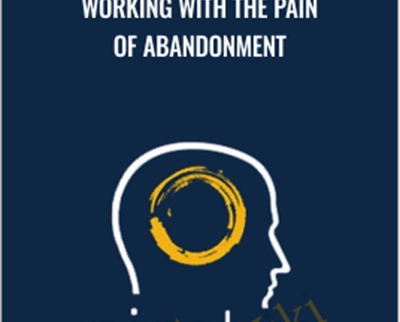$197.00 Original price was: $197.00.$43.00Current price is: $43.00.
Being abandoned hurts. In the moment, it can feel like you can’t breathe and that life is about to end. And then comes the painful sensations that ripple through the body and fill you with paralyzing panic.
 Purchase this course you will earn 43 Points worth of $4.30
Purchase this course you will earn 43 Points worth of $4.30Working with Abandonment: 26 Top Experts Share the Latest Strategies to Help Clients Heal
Being abandoned hurts. In the moment, it can feel like you can’t breathe and that life is about to end. And then comes the painful sensations that ripple through the body and fill you with paralyzing panic.
When this happens to a client, they can become fearful of ever experiencing abandonment again. Problem is, they can then develop harmful coping strategies that not only create more pain, but put them at even greater risk of being rejected.
So how do we work with the desperate behavior and hair-trigger nervous system that can make abandonment a self-fulfilling prophecy?
We turned to the world’s 26 top experts to hear how they work with clients who have been abandoned. Here are the latest strategies that you can start using in your work today.
Working with the Pain of Abandonment
How to Work with Clients Who Are Hypersensitive to Rejection
Peter Levine, PhD Ron Siegel, PsyD Judson Brewer, MD, PhD Melanie Greenberg, PhD
- The specific neural pattern that fuels a fear of abandonment
- One way to help clients shift out of a rejection-oriented mindset
- How to work with a client’s panic when being rejected
Key Strategies for Working with Abandonment and Trauma
Bessel van der Kolk, MD Peter Levine, PhD Kelly McGonigal, PhD Resmaa Menakem, MSW, LICSW, SEP Melanie Greenberg, PhD
- How PTSD can lead to powerful brain schemas that invite rejection from others
- One practice to help clients with panic disorder regulate their body when triggered by abandonment
- How trauma-informed neurofeedback can neutralize reactivity to an experience of rejection
How to Approach Shame That Drives a Fear of Rejection
Dan Siegel, MD
- How the ruminating brain can lock clients into ambivalent relationships that invite shame
- How to work with clients whose sense of defectiveness fuels a fear of abandonment
How to Recondition a Nervous System Damaged by Abandonment
Stephen Porges, PhD Deb Dana, LCSW
- How abandonment leaves a deep tracing on the nervous system (and what this means for treatment)
- Why the nervous system will often sabotage offers to co-regulate
- How to help a client’s nervous system tolerate ruptures in a relationship
How to Read the Abandonment Story Your Client’s Body Is Telling
Pat Ogden, PhD Bonnie Goldstein, PhD Deb Dana, LCSW
- How to recognize possible signs of early life abandonment in your client’s body
- How a client’s physiology can reveal the way they’re managing a fear of abandonment
Ways to Change Fearful Behavior That Sets a Client Up for Further Abandonment
Pat Ogden, PhD Melanie Greenberg, PhD Ron Siegel, PsyD Donald Meichenbaum, PhD Terry Real, MSW, LICSW
- Two specific ways a client’s fear of abandonment can become a self-fulfilling prophecy
- How to reframe a client’s neediness to make it an ally in their healing
- How to help a client stay regulated when their partner rejects their needs
How to Help Clients Stop Sacrificing Their Boundaries to Avoid Being Abandoned
Joan Borysenko, PhD Kelly McGonigal, PhD Ron Siegel, PsyD Judson Brewer, MD, PhD Melanie Greenberg, PhD Pat Ogden, PhD
- The addiction model that leads a client to soften their boundaries (and how to change it)
- The painful reason why some clients will gamble away their principles in a relationship
- Two practical ways to help clients shore up their personal boundaries
A 3-Step Strategy to Expand a Client’s Tolerance of Rejection
Steven Hayes, PhD Kelly McGonigal, PhD
- How to help clients engage their fear of abandonment without getting overwhelmed
- How to adjust your treatment of abandonment when the client dissociates
- A compassionate strategy to help clients break a paralyzing fear of abandonment
How to Treat A Fear of Abandonment Linked to Betrayal
Shelly Harrell, PhD Richard Schwartz, PhD Stan Tatkin, PsyD, MFT
- One way to reduce the stigma and humiliation a client attaches to their experience of betrayal
- The damaging way clients often approach decisions when they fear loss
Here's What You'll Get:
Everything is yours to keep forever in your professional library
- Downloadable videos so you can watch at your convenience, on any device
- Audio recordings you can download and listen to at home, in the car, at the gym or wherever you like
- Professionally-formatted transcripts of the sessions, to make review and action simple
- Three downloadable bonus videos to help you work with a Client’s Pain of Abandonment
Why the Transcript Is Essential:

- The transcript makes it easy to go back and double check concepts, citations and names that are mentioned
- We put in a table of contents to make it easy for you to find the exact part of the webinar you need
- Having the concepts already written allows you to take notes on how you’re going to use the ideas rather than transcribing the ideas
- Some people simply learn better by reading than by listening or watching
- You will be able to print out and share techniques presented in the session with your patients
Get Working with the Pain of Abandonment – NICABM, Only Price $47
Tag: Working with the Pain of Abandonment – NICABM Review. Working with the Pain of Abandonment – NICABM download. Working with the Pain of Abandonment – NICABM discount.
Only logged in customers who have purchased this product may leave a review.
Related products
= 85 Points
= 94 Points
Uncategorized
Managing Geriatric Behaviors: Wandering, Aggression, Malnutrition and More – Steven Atkinson
= 35 Points
Uncategorized
Proven Fall Prevention Strategies: Exercise, Meds Management and Home Modification – Trent Brown
= 40 Points
Uncategorized
= 85 Points
Uncategorized
= 30 Points
Uncategorized
= 85 Points
Uncategorized
Optimizing Compliance and Maximizing Revenue for Ophthalmology and Optometry – Jeffrey P. Restuccio
= 85 Points





Reviews
There are no reviews yet.